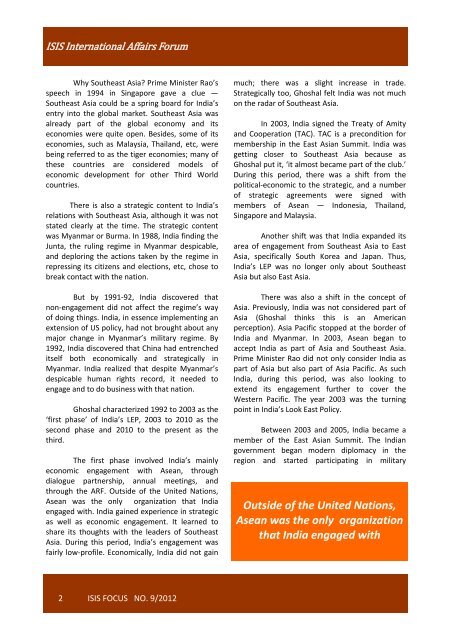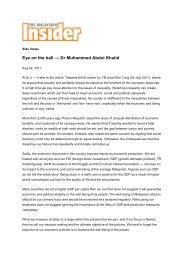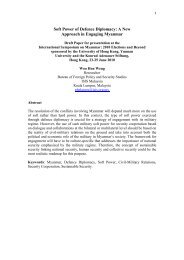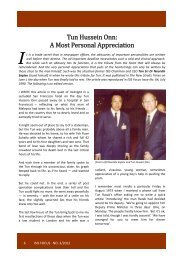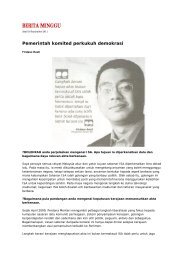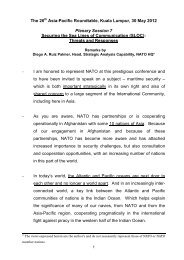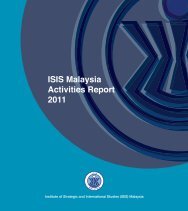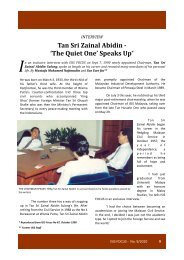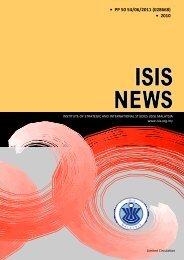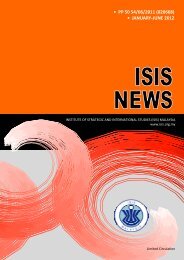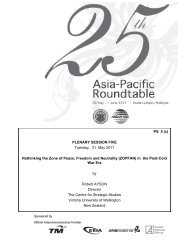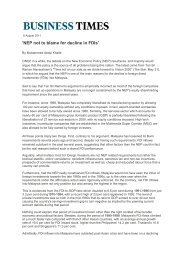India's Look East Policy - ISIS Malaysia
India's Look East Policy - ISIS Malaysia
India's Look East Policy - ISIS Malaysia
You also want an ePaper? Increase the reach of your titles
YUMPU automatically turns print PDFs into web optimized ePapers that Google loves.
<strong>ISIS</strong> International Affairs Forum<br />
Why Southeast Asia Prime Minister Rao’s<br />
speech in 1994 in Singapore gave a clue —<br />
Southeast Asia could be a spring board for India’s<br />
entry into the global market. Southeast Asia was<br />
already part of the global economy and its<br />
economies were quite open. Besides, some of its<br />
economies, such as <strong>Malaysia</strong>, Thailand, etc, were<br />
being referred to as the tiger economies; many of<br />
these countries are considered models of<br />
economic development for other Third World<br />
countries.<br />
There is also a strategic content to India’s<br />
relations with Southeast Asia, although it was not<br />
stated clearly at the time. The strategic content<br />
was Myanmar or Burma. In 1988, India finding the<br />
Junta, the ruling regime in Myanmar despicable,<br />
and deploring the actions taken by the regime in<br />
repressing its citizens and elections, etc, chose to<br />
break contact with the nation.<br />
But by 1991‐92, India discovered that<br />
non‐engagement did not affect the regime’s way<br />
of doing things. India, in essence implementing an<br />
extension of US policy, had not brought about any<br />
major change in Myanmar’s military regime. By<br />
1992, India discovered that China had entrenched<br />
itself both economically and strategically in<br />
Myanmar. India realized that despite Myanmar’s<br />
despicable human rights record, it needed to<br />
engage and to do business with that nation.<br />
Ghoshal characterized 1992 to 2003 as the<br />
‘first phase’ of India’s LEP, 2003 to 2010 as the<br />
second phase and 2010 to the present as the<br />
third.<br />
The first phase involved India’s mainly<br />
economic engagement with Asean, through<br />
dialogue partnership, annual meetings, and<br />
through the ARF. Outside of the United Nations,<br />
Asean was the only organization that India<br />
engaged with. India gained experience in strategic<br />
as well as economic engagement. It learned to<br />
share its thoughts with the leaders of Southeast<br />
Asia. During this period, India’s engagement was<br />
fairly low‐profile. Economically, India did not gain<br />
much; there was a slight increase in trade.<br />
Strategically too, Ghoshal felt India was not much<br />
on the radar of Southeast Asia.<br />
In 2003, India signed the Treaty of Amity<br />
and Cooperation (TAC). TAC is a precondition for<br />
membership in the <strong>East</strong> Asian Summit. India was<br />
getting closer to Southeast Asia because as<br />
Ghoshal put it, ‘it almost became part of the club.’<br />
During this period, there was a shift from the<br />
political‐economic to the strategic, and a number<br />
of strategic agreements were signed with<br />
members of Asean — Indonesia, Thailand,<br />
Singapore and <strong>Malaysia</strong>.<br />
Another shift was that India expanded its<br />
area of engagement from Southeast Asia to <strong>East</strong><br />
Asia, specifically South Korea and Japan. Thus,<br />
India’s LEP was no longer only about Southeast<br />
Asia but also <strong>East</strong> Asia.<br />
There was also a shift in the concept of<br />
Asia. Previously, India was not considered part of<br />
Asia (Ghoshal thinks this is an American<br />
perception). Asia Pacific stopped at the border of<br />
India and Myanmar. In 2003, Asean began to<br />
accept India as part of Asia and Southeast Asia.<br />
Prime Minister Rao did not only consider India as<br />
part of Asia but also part of Asia Pacific. As such<br />
India, during this period, was also looking to<br />
extend its engagement further to cover the<br />
Western Pacific. The year 2003 was the turning<br />
point in India’s <strong>Look</strong> <strong>East</strong> <strong>Policy</strong>.<br />
Between 2003 and 2005, India became a<br />
member of the <strong>East</strong> Asian Summit. The Indian<br />
government began modern diplomacy in the<br />
region and started participating in military<br />
Outside of the United Nations,<br />
Asean was the only organization<br />
that India engaged with<br />
2 <strong>ISIS</strong> FOCUS NO. 9/2012


